Abstract
The reactions catalyzed by Mo enzymes each find the product differing from the substrate by two electrons and two protons (or some multiple thereof). The coordination chemistry of Mo suggests that there is a distinct relationship between acid-base and redox properties of Mo complexes, and that a coupled electron-proton transfer (to or from substrate) may be mediated by Mo in enzymes. Each of the Mo enzymes (nitrogenase, nitrate reductase, xanthine oxidase, aldehyde oxidase, and sulfite oxidase) is discussed; it is shown that a simple molecular mechanism embodying coupled proton-electron transfer can explain many key experimental observations. In view of this mechanism, the reasons for the use of Mo (from an evolutionary and chemical point of view) are discussed and other metals that may replace Mo are considered.
Keywords: metalloenzymes, nitrogenase, nitrate reductase, xanthine oxidase, ligand acidity
Full text
PDF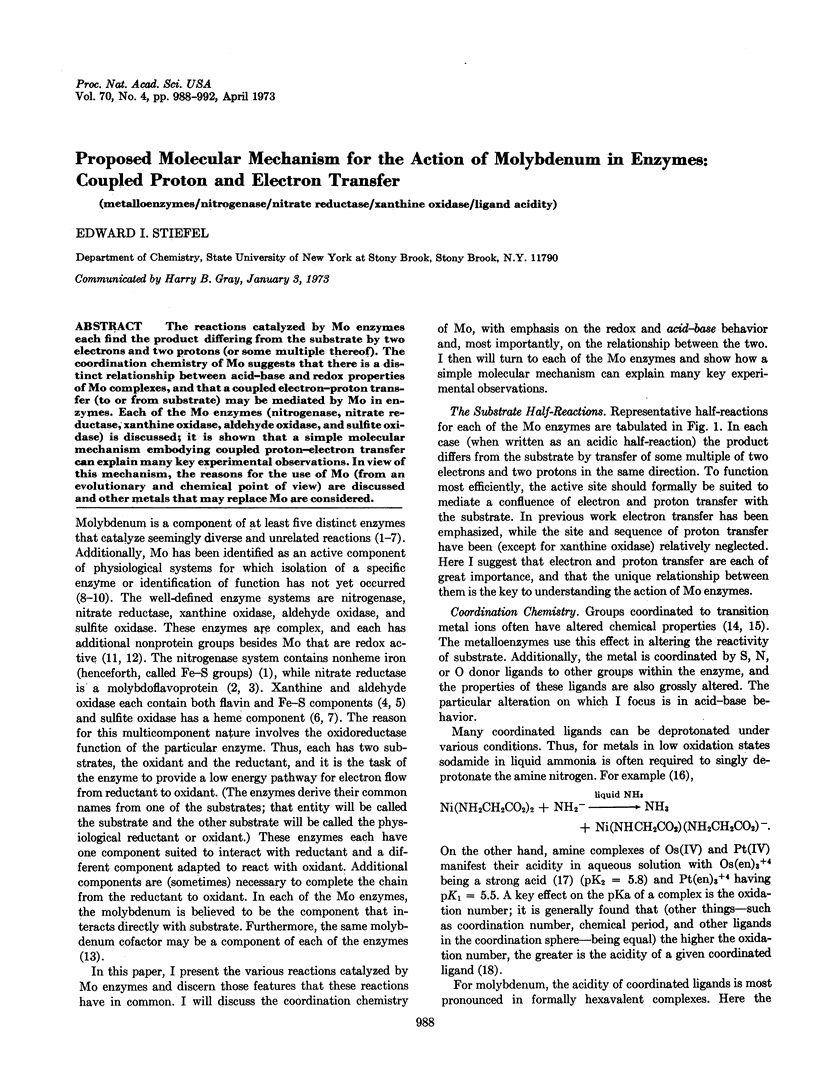
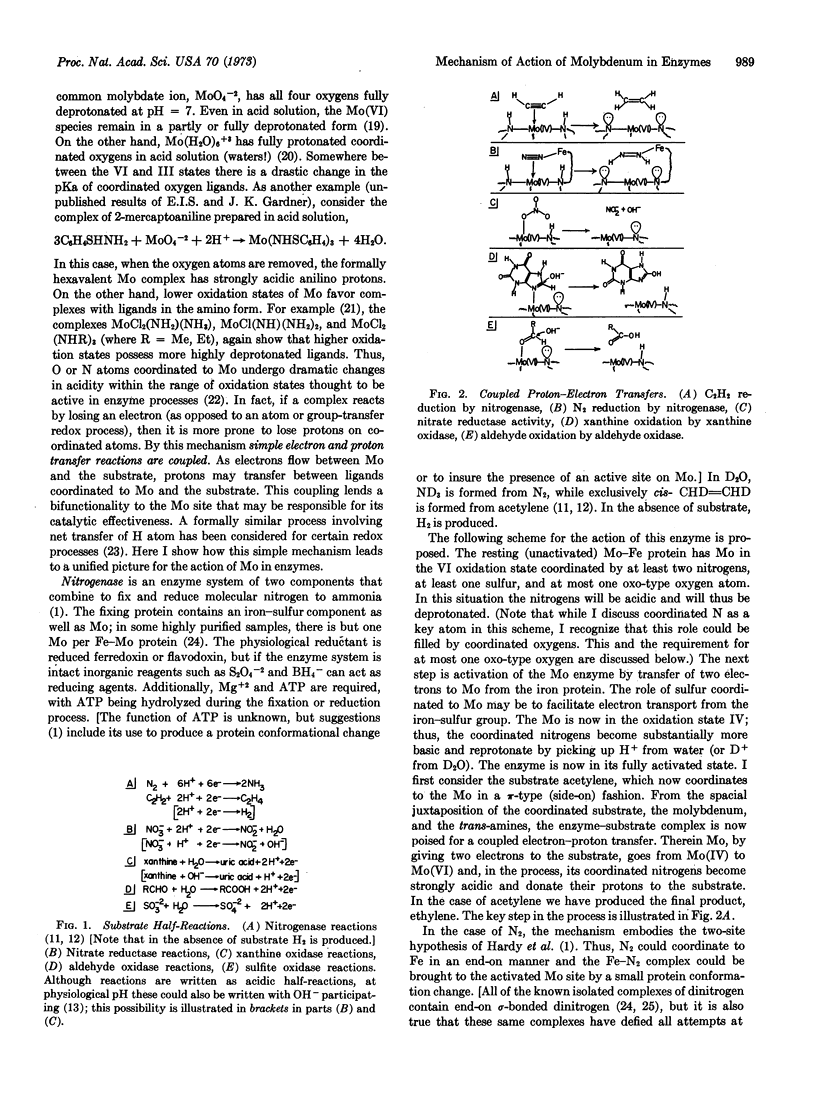
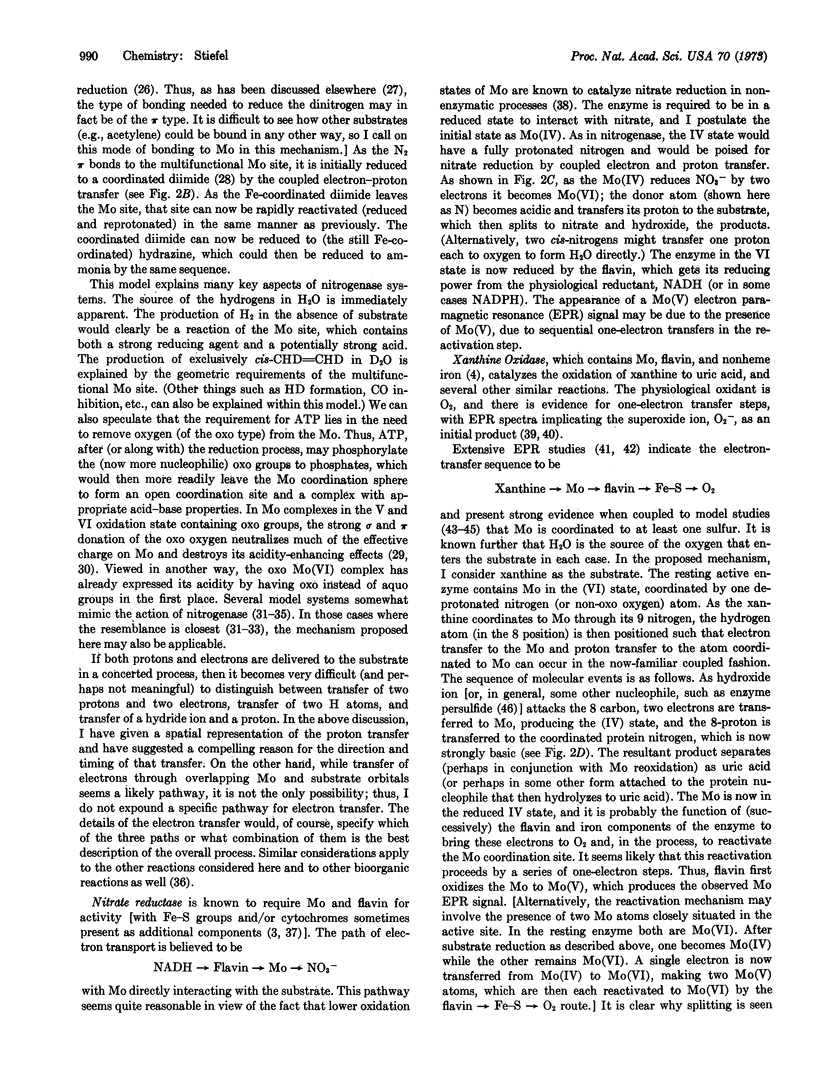
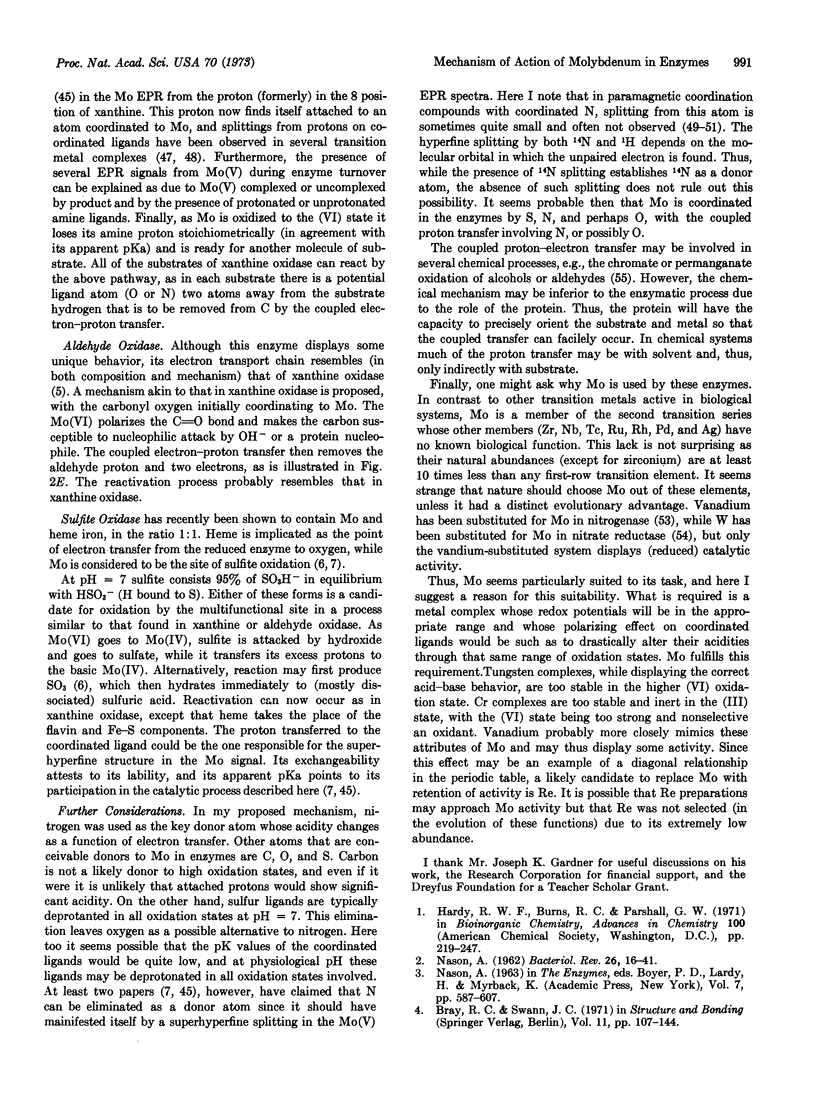
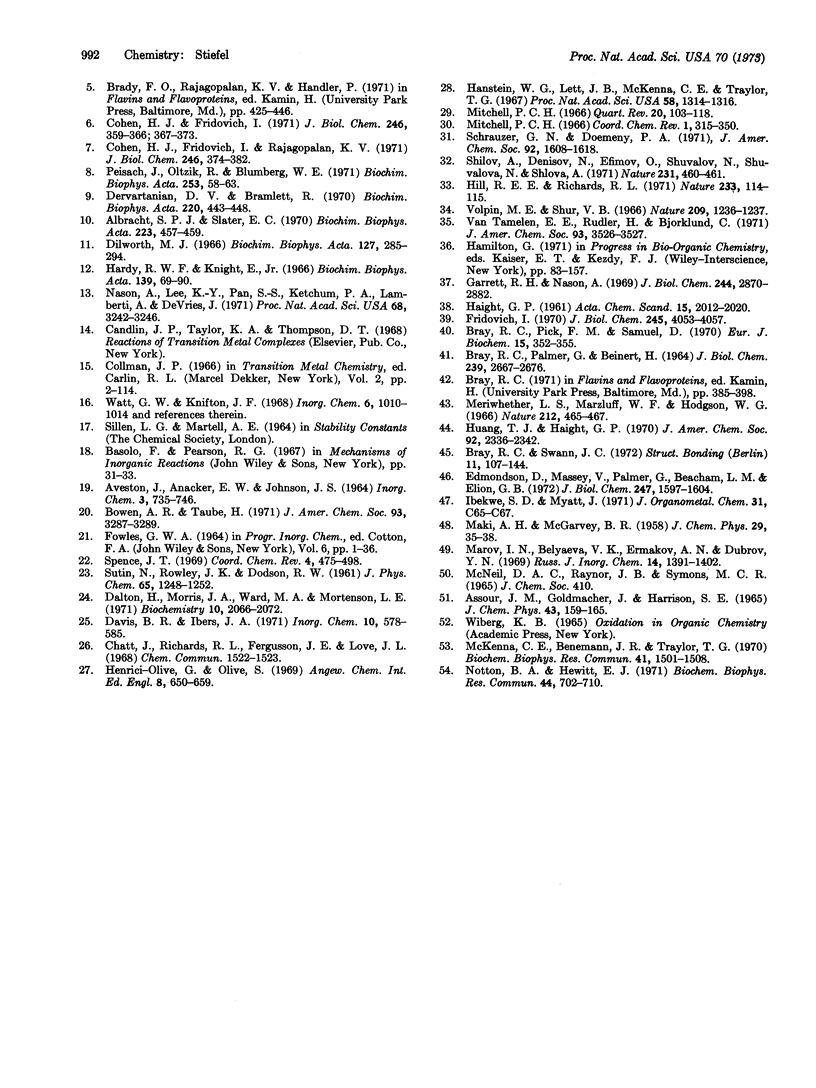
Selected References
These references are in PubMed. This may not be the complete list of references from this article.
- Albracht S. P., Slater E. C. Molybdenum associated with NADH dehydrogenase in complex I. Biochim Biophys Acta. 1970 Dec 8;223(2):457–459. doi: 10.1016/0005-2728(70)90209-4. [DOI] [PubMed] [Google Scholar]
- BRAY R. C., PALMER G., BEINERT H. DIRECT STUDIES ON THE ELECTRON TRANSFER SEQUENCE IN XANTHINE OXIDASE BY ELECTRON PARAMAGNETIC RESONANCE SPECTROSCOPY. II. KINETIC STUDIES EMPLOYING RAPID FREEZING. J Biol Chem. 1964 Aug;239:2667–2676. [PubMed] [Google Scholar]
- Bray R. C., Pick F. M., Samuel D. Oxygen-17 hyperfine splitting in the electron paramagnetic resonance spectrum of enzymically generated superoxide. Eur J Biochem. 1970 Aug;15(2):352–355. doi: 10.1111/j.1432-1033.1970.tb01014.x. [DOI] [PubMed] [Google Scholar]
- Cohen H. J., Fridovich I. Hepatic sulfite oxidase. Purification and properties. J Biol Chem. 1971 Jan 25;246(2):359–366. [PubMed] [Google Scholar]
- Cohen H. J., Fridovich I., Rajagopalan K. V. Hepatic sulfite oxidase. A functional role for molybdenum. J Biol Chem. 1971 Jan 25;246(2):374–382. [PubMed] [Google Scholar]
- Dalton H., Morris J. A., Ward M. A., Mortenson L. E. Purification and some properties of molybdoferredoxin, a component of nitrogenase from Clostridium pasteurianum. Biochemistry. 1971 May 25;10(11):2066–2072. doi: 10.1021/bi00787a016. [DOI] [PubMed] [Google Scholar]
- Dervartanian D. V., Bramlett R. Electron paramagnetic resonance studies of 95Mo-enriched NADH dehydrogenase isolated from iron-deficient Azotobacter vinelandii. Biochim Biophys Acta. 1970 Dec 16;220(3):443–448. doi: 10.1016/0005-2744(70)90275-5. [DOI] [PubMed] [Google Scholar]
- Dilworth M. J. Acetylene reduction by nitrogen-fixing preparations from Clostridium pasteurianum. Biochim Biophys Acta. 1966 Oct 31;127(2):285–294. doi: 10.1016/0304-4165(66)90383-7. [DOI] [PubMed] [Google Scholar]
- Edmondson D., Massey V., Palmer G., Beacham L. M., 3rd, Elion G. B. The resolution of active and inactive xanthine oxidase by affinity chromatography. J Biol Chem. 1972 Mar 10;247(5):1597–1604. [PubMed] [Google Scholar]
- Fridovich I. Quantitative aspects of the production of superoxide anion radical by milk xanthine oxidase. J Biol Chem. 1970 Aug 25;245(16):4053–4057. [PubMed] [Google Scholar]
- Garrett R. H., Nason A. Further purification and properties of Neurospora nitrate reductase. J Biol Chem. 1969 Jun 10;244(11):2870–2882. [PubMed] [Google Scholar]
- Hanstein W. G., Lett J. B., McKenna C. E., Traylor T. G. Heme protein-diimide complex- es: possible intermediates in biological nitrogen fixation. Proc Natl Acad Sci U S A. 1967 Oct;58(4):1314–1316. doi: 10.1073/pnas.58.4.1314. [DOI] [PMC free article] [PubMed] [Google Scholar]
- Hardy R. W., Knight E., Jr ATP-dependent reduction of azide and HCN by N2-fixing enzymes of Azotobacter vinelandii and Clostridium pasteurianum. Biochim Biophys Acta. 1967 May 16;139(1):69–90. doi: 10.1016/0005-2744(67)90114-3. [DOI] [PubMed] [Google Scholar]
- Hill R. E., Richards R. L. Reduction of dinitrogen in aqueous solution. Nature. 1971 Sep 10;233(5315):114–115. doi: 10.1038/233114a0. [DOI] [PubMed] [Google Scholar]
- Huang T. J., Haight G. P., Jr A paramagnetic monomeric molybdenum(V)-cysteine complex as a model for molybdenum-enzyme interaction. J Am Chem Soc. 1970 Apr 22;92(8):2336–2342. doi: 10.1021/ja00711a024. [DOI] [PubMed] [Google Scholar]
- McKenna C. E., Benemann J. R., Traylor T. G. A vanadium containing nitrogenase preparation: implications for the role of molybdenum in nitrogen fixation. Biochem Biophys Res Commun. 1970 Dec 24;41(6):1501–1508. doi: 10.1016/0006-291x(70)90557-7. [DOI] [PubMed] [Google Scholar]
- Meriwether L. S., Marzluff W. F., Hodgson W. G. Molybdenum-thiol complexes as models for molybdenum bound in enzymes. Nature. 1966 Oct 29;212(5061):465–467. doi: 10.1038/212465a0. [DOI] [PubMed] [Google Scholar]
- NASON A. Symposium on metabolism of inorganic compounds. II. Enzymatic pathways of nitrate, nitrite, and hydroxylamine metabolisms. Bacteriol Rev. 1962 Mar;26:16–41. doi: 10.1128/br.26.1.16-41.1962. [DOI] [PMC free article] [PubMed] [Google Scholar]
- Nason A., Lee K. Y., Pan S. S., Ketchum P. A., Lamberti A., DeVries J. Invitro formation of assimilatory reduced nicotinamide adenine dinucleotide phosphate: nitrate reductase from a Neurospora mutant and a component of molybdenum-enzymes. Proc Natl Acad Sci U S A. 1971 Dec;68(12):3242–3246. doi: 10.1073/pnas.68.12.3242. [DOI] [PMC free article] [PubMed] [Google Scholar]
- Notton B. A., Hewitt E. J. The role of tungsten in the inhibition of nitrate reductase activity in spinach (spinacea oleracea L.) leaves. Biochem Biophys Res Commun. 1971 Aug 6;44(3):702–710. doi: 10.1016/s0006-291x(71)80140-7. [DOI] [PubMed] [Google Scholar]
- Peisach J., Oltzik R., Blumberg W. E. The electron paramagnetic resonance of molybdenum in rat liver and in rat liver mitochondria. Biochim Biophys Acta. 1971 Nov 2;253(1):58–63. doi: 10.1016/0005-2728(71)90233-7. [DOI] [PubMed] [Google Scholar]
- Shilov A., Denisov N., Efimov O., Shuvalov N., Shuvalova N., Shilova A. New nitrogenase model for reduction of molecular nitrogen in protonic media. Nature. 1971 Jun 18;231(5303):460–461. doi: 10.1038/231460a0. [DOI] [PubMed] [Google Scholar]
- van Tamelen E. E., Rudler H., Bjorklund C. Transition metal promoted organic reactions as models for nitrogenase behavior. J Am Chem Soc. 1971 Jul 14;93(14):3526–3527. doi: 10.1021/ja00743a038. [DOI] [PubMed] [Google Scholar]


